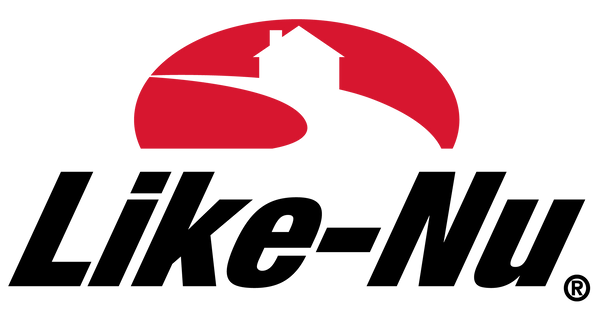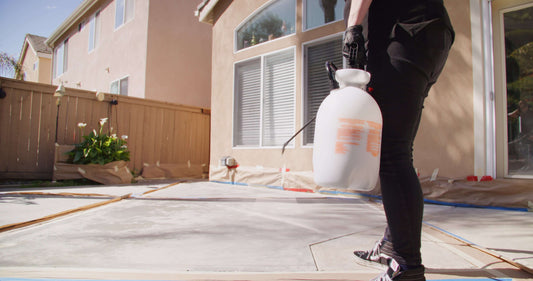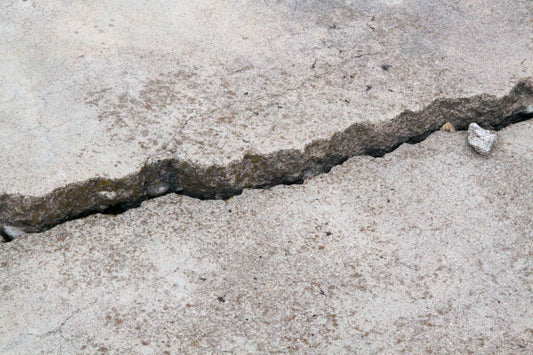Have you ever tripped over an uneven concrete slab or watched your outdoor furniture wobble precariously? Concrete slabs, while durable, can develop issues over time that not only look unsightly but also pose safety hazards. From driveways to patios, these sturdy surfaces often bear the brunt of weather, soil shifts, and heavy loads, leading to cracks, sinking, or uneven surfaces. Fixing these problems is crucial to maintain both the esthetic appeal and functionality of your concrete spaces.
In this article, we'll explore the top methods to fix uneven concrete slabs. We'll dive into the causes behind these pesky problems and look at cost-effective solutions like concrete leveling. We'll also check out grinding and resurfacing techniques that can breathe new life into worn-out surfaces. Finally, we'll help you decide whether to repair or replace your concrete, giving you the know-how to tackle those troublesome slabs head-on. So, let's get ready to smooth things out and bring your concrete back to its former glory!
Understanding the Causes of Uneven Concrete Slabs
Concrete slabs, while sturdy, can develop issues over time. Let's dive into the main culprits behind those pesky uneven surfaces that make your outdoor furniture do the wobble dance.
Soil Settlement
Ever wonder why your once-smooth driveway now resembles a mini roller coaster? Blame it on the soil! When the ground beneath your concrete decides to take a nap, it settles and compresses, leaving your slab high and dry - or rather, low and uneven . This settling act can take anywhere from 5 to 10 years, especially if the soil wasn't properly compacted during construction .
Erosion
Water, the sneaky culprit, loves to play hide and seek with your soil. When it finds its way under your concrete, it whisks away particles, creating voids that cause the slab to sink . It's like a game of Jenga, but with your driveway! Poorly aimed downspouts, overflowing gutters, and landscapes that slope towards your concrete are all accomplices in this erosion escapade .
Tree Root Growth
Trees: nature's gentle giants with not-so-gentle roots. These underground explorers can push up your concrete as they search for water and nutrients . It's like they're trying to give your sidewalk a high-five from below! The root system of a tree can extend twice the size of its canopy, so that innocent-looking tree might be causing more trouble than you think .
Poor Initial Installation
Sometimes, the problem starts before the concrete even sets. Poor compaction during installation is like building a house of cards - it's bound to fall eventually . Contractors in a hurry might skip proper soil preparation, leaving you with a slab that's destined to sink . It's a reminder that sometimes, slow and steady really does win the race!
Concrete Leveling: A Cost-Effective Solution
When it comes to fixing uneven concrete slabs, concrete leveling offers a wallet-friendly solution that doesn't require breaking the bank or the concrete. Let's dive into two popular methods that can bring your wobbly surfaces back to level ground.
Mudjacking Process
Mudjacking, also known as slabjacking or concrete lifting, is like giving your concrete a mud bath with a twist. Here's how it works:
- Contractors drill strategically placed holes (about 2 inches wide) in the slab.
- A mud-like slurry of Portland cement, water, and other materials is pumped through these holes.
- This mixture spreads out, filling voids and lifting the slab.
- Once level, the holes are patched up.
The whole process usually takes just a few hours, and you can walk on it soon after .
Polyjacking Process
Polyjacking, or foam concrete lifting, is the high-tech cousin of mudjacking. It's like giving your concrete slab a foam party:
- Tiny holes (about ⅝ inches) are drilled into the slab.
- Liquid polyurethane foam is injected through these holes.
- The foam expands, lifting the concrete.
- Holes are sealed once the desired level is reached.
This method cures quickly, allowing for immediate use in most cases .
Pros and Cons of Each Method
Both methods have their strengths and quirks. Here's a quick rundown:
Mudjacking:
- Pros: Cost-effective, time-tested method.
- Cons: Larger holes, potential for future settling.
Polyjacking:
- Pros: Smaller holes, longer-lasting results, cleaner process.
- Cons: More expensive, potential for over-lifting.
Polyjacking typically costs 20-50% more than other methods but offers better long-term stability . However, both options are significantly cheaper than full concrete replacement, making them attractive for budget-conscious homeowners looking to smooth out their surfaces.
Grinding and Resurfacing Techniques
Concrete Grinding
Concrete grinding is a straightforward process that sands down the surface to reduce offsets, trip hazards, or uneven areas . It's a cost-effective way to achieve safe, even concrete. Most of the time, a handheld angle grinder with an attached diamond cup wheel does the job . For larger areas, walk-behind grinding units come in handy .
The process involves getting down on your knees and working away at the offset concrete until it's no longer a trip hazard . But watch out! This creates a lot of dust, so attaching a vacuum to the grinder is a smart move . Safety first, folks! Wear those goggles and dust masks to avoid silicosis, a serious health problem that can result from breathing in concrete dust .
Grinding is ideal when you need to take off less than two inches. Any more than that, and you risk weakening the concrete. It's a quick fix but comes with some drawbacks. The ground surface can absorb more water, leading to increased damage during freeze-thaw cycles .
Overlay and Resurfacing Options
When grinding isn't enough, concrete resurfacing comes to the rescue. It involves applying a thin layer of cement-based overlay to the existing surface. This method is perfect for driveways, patios, and pool decks, offering a fresh look without breaking the bank.
Replacement vs. Repair: Making the Right Choice
When it comes to fixing concrete slabs, homeowners often find themselves at a crossroads: should they repair or replace? It's not always a straightforward decision, but let's break it down.
Factors to Consider
The extent of damage plays a crucial role in this decision. If the concrete is showing its age with minor cracks or settling, repair might be the way to go. However, if your concrete is older than 40 years or has deep cracks and large potholes, it might be time to say goodbye .
Cost Comparison
Money talks, and in this case, it's saying "repair" is often cheaper. The average cost of concrete repair ranges from $800 to $5,000, while installing a new concrete driveway can set you back $3,200 to $50,000. That's quite a difference!
Long-Term Benefits
While repairs can be a quick fix, replacement often provides longer-lasting results. A new concrete driveway can last 30 to 50 years, twice as long as its asphalt counterpart. Plus, if you're looking to sell your home, a fresh concrete surface can boost your curb appeal and home value .
Final Touches: Resurfacing with Like-Nu Concrete Restoration Kit
When you are finally done fixing the uneven concrete, now is the time for the finishing touches - resurfacing with the Like-Nu Concrete Restoration Kit. It's more affordable than replacement, costing less than $1 per square foot compared to $3 to $10 per square foot for other brands. Plus, it's eco-friendly as you're not tossing out the old concrete. It's like giving your concrete a facelift without the hefty price tag! All while putting the finishing touches on that old concrete - making it Like-Nu again.
Conclusion
Fixing uneven concrete slabs doesn't have to be a headache. From mudjacking to polyjacking, grinding to resurfacing, there are plenty of options to smooth out those troublesome surfaces. The key is to assess the damage and choose the method that fits your needs and budget. Remember, sometimes a simple repair can save you big bucks compared to a full replacement.
In the end, the goal is to create safe, level surfaces that look great and stand the test of time. Whether you're dealing with a wonky driveway or a tilted patio, there's a solution out there. To give your concrete a fresh new look after leveling, try out the Like-Nu Concrete Restoration Kit. With the right approach, you can turn those uneven slabs into smooth, sturdy surfaces that'll make your outdoor spaces shine for years to come.
FAQs
1. What are some methods to correct an uneven concrete slab?
To address minor unevenness, grinding down high spots and filling low spots with concrete patching compound is effective. For more significant unevenness, a self-leveling compound can be poured over the surface. In severe cases, techniques such as mudjacking or replacing the slab might be necessary.
2. Is it possible to apply self-leveling concrete over an existing concrete slab?
Yes, self-leveling concrete, which is thinner and flows more easily than regular concrete, can be mixed with water and poured over an existing concrete slab to create an even surface.
3. How can a concrete slab be re-leveled?
Re-leveling a concrete slab involves drilling holes strategically through the slab and pumping a leveling compound underneath. The pressure from the compound raises the slab to the desired level, and the holes are then sealed.
4. What is the simplest method to level an uneven concrete floor?
The easiest way to level an uneven concrete floor involves identifying low spots, applying a concrete leveling compound, and allowing it to dry. Optionally, finishing with a grinder and sealing the floor can further enhance the result.
5. Can you describe a cost-effective method for fixing very uneven concrete subfloors?
For minor unevenness, using a self-leveling compound is both effective and economical. For larger imperfections, grinding or using a patching compound may be necessary. In cases of significant unevenness, mudjacking might be the best solution despite being more costly.
6. What are self-leveling overlay systems for concrete floors?
Self-leveling overlays are polymer-modified toppings that can level uneven floors without troweling. They are used to repair damaged concrete and create a smooth surface for decorative treatments or other floor coverings.
7. How should one prepare and apply a self-leveling compound on an uneven concrete sub-floor?
First, clean the sub-floor and repair any large cracks. Mix the self-leveling compound as per the manufacturer's instructions, pour it onto the floor, spread it with a trowel, and allow it to cure as directed. This method is suitable for minor to moderate unevenness.
8. What considerations should be made when choosing a method to fix an uneven concrete floor?
Assess the severity of the unevenness to choose the appropriate method. Preparation of the surface is crucial, and following manufacturer instructions for the chosen method ensures the best results. Consider the budget and the extent of unevenness when selecting a method.





